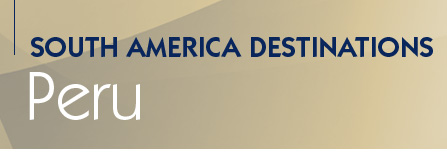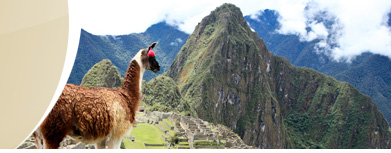ANDEAN REGION
THE ANDES (Cusco, Sacred Valley, Machu Picchu, Arequipa, Puno & Lake Titicaca)
The Peruvian Andes occupy the central part of the Andean region of South America. Divided into the northern Andes and southern Andes they comprise more than 1000 mountains over 16,400 feet above sea level and dozens over 19,700 feet above sea level. This immense geographical formation is the hub of Andean culture and home too much of its centuries old History. Though the high valleys from 8,200 to 9,800 feet above sea level are sparsely populated they are home to a significant portion of the Indigenous population.
The first populations here are over ten thousand years old and are precursors of the later developed civilizations such as Chavin, Tiahuanaco that culminated with the Inca Empire, a powerful civilization that finally extended in the sixteenth century from Cusco, its capital, to the ancient kingdom of Quito in Ecuador and great part of what is today Chile and Bolivia. The Inca Empire constituted a military and theocratic state based on the mobilization of a vast number of taxpaying citizens and the control of agricultural surpluses. Known for outstanding agriculture, ceramics and gold and silver work, the Inca Empire also left monumental architecture and amazing feats of hydraulic engineering.
CUSCO AND THE SACRED VALLEY
Four roads once led from Cusco’s main square to the four corners of the Inca empire that extended from what is today Ecuador and part of Colombia to northern Chile and Argentina, including all of Peru and Bolivia. An empire almost as vast as the Roman Empire, the Inca nation was connected by a road network stretching over 23,000 km. (14,300 miles). Due to its position as the capital of the Inca dynasty, contemporary Cusco, a city 3,300 meters/10,500 ft. above sea level is a showcase of several different cultures: Pre-Inca, Inca, Colonial and republican. But Cusco was more than just a capital city. It was an administrative, military and holy city, similar to Mecca, and is now the oldest inhabited city of the Americas. Many kinds of architecture are found here and one’s eyes can feast on their splendid variety and combinations
The Temple of the Sun, Inca’s most sacred building in Cusco today forms part of the Spanish church of Santo Domingo. Ruins, temples, churches, and mansions make this a memorable destination, full of history and culture. A city with a splendid legacy, Cusco’s winding cobbled streets transport visitors through its rich and beautiful past.
The surrounding countryside is stunning, much of it sculpted by agricultural terraces once watered by complex irrigation systems. A stay in Urubamba, the Sacred Valley, is the perfect way to relax in the heart of the country. Cusco is also the departure point for visits to the Inca citadel of Machu Picchu, which can be reached by train, via the Inca trail, or helicopter.
MACHU PICCHU
At a distance of 120 km. (75 miles) from Cusco, in the valley of the Urubamba River, Machu Picchu rises to an altitude of 2,400 meters (7,900 ft.) above sea level between the Huayna Picchu (young peak) and Machu Picchu (old peak). It lies within the spectacular framework provided by the exuberant vegetation of nearby jungle and the rugged landscape.
The ruins are situated on the eastern slope of Machu Picchu in two different areas: the agricultural and the urban. The latter includes the civil sector (dwellings, canalizations), and the sacred sector (temples, mausoleums, squares, royal houses). Although constructions show different levels of architecture, religious buildings exhibit a high degree of perfection. The construction was with general use of stone, and the roofs were built of tree trunks and thatched with ichu straw. The walls were made with an inward inclination for protection against earthquakes.
From the peak of the Huayna Picchu, situated opposite Machu Picchu, there is a prodigious panoramic view of the imposing mass of ruins and the Urubamba valley. The breathtaking views from this mountaintop citadel and its well-preserved ruins are a photographer dream.
AREQUIPA
Arequipa, Peru’s second largest city, is located 1,024 km. (640 miles) South of Lima. It was founded in 1540 and is one of the country’s most attractive cities. Full of colonial churches and mansions, including Santa Catalina, a restored convent established in 1579 and now open to the public after being closed for 400 years, Arequipa is known as the White City because much of it is built with ashlar, a smooth white building stone carved from volcanic lava quarries.
Three volcanoes dominate the skyline: Misti, Chachani and Pichu Pichu. North of Arequipa lies the spectacular Colca Valley, a picturesque Andean valley dotted with towns founded in colonial times.
The canyon is one of the deepest in the world and home of the majestic condor. Arequipa’s mild climate and altitude (2,300 meter above sea level – 7,500 ft.) is ideal to acclimatize oneself before continuing the trip to Cusco or Puno.
PUNO AND LAKE TITICACA
Perched at a breathtaking 3,800 meters (12,400 ft.) above sea level, Puno and the surrounding countryside are the cradle of the Aymara civilization and the legendary birthplace of the founders of the Inca empire. Puno lies on the shore of Lake Titicaca, the world’s highest navigable lake, from whose waters the Inca believed Manco Capac, their cultural founder, emerged. Many ethnic groups like the Uros still depend on the resources of the lake for their living. The Uros themselves dwell on the floating islands they build with the lake’s reed vegetation. Near Puno, overlooking Lake Umayo, are chullpas, or burial towers, that once served as the tombs of high-ranking Aymara Lords.
Three and a half hours from Puno by boat lies the Island of Taquile, where life has remained unchanged from centuries and weavers still craft traditional textiles. North of Taquile is the Island of Amantani, famed for its woven straw baskets. An overnight stay on one of this islands is an unforgettable experience and highly recommended. Surrounding the lake, dozens of colonial settlements and their ornate churches bear witness to the lake’s importance during colonial times. Puno is famed as the folklore capital of Peru. Be sure to take in at least one of the innumerable folk festivals that punctuate Puno’s festival calendar. The Virgen de la Candelaria, held in February, its a three-day spectacle rich in traditional folklore.



